INFINITI QX50 2019 Owner's Manual
Manufacturer: INFINITI, Model Year: 2019, Model line: QX50, Model: INFINITI QX50 2019Pages: 573, PDF Size: 7.4 MB
Page 261 of 573
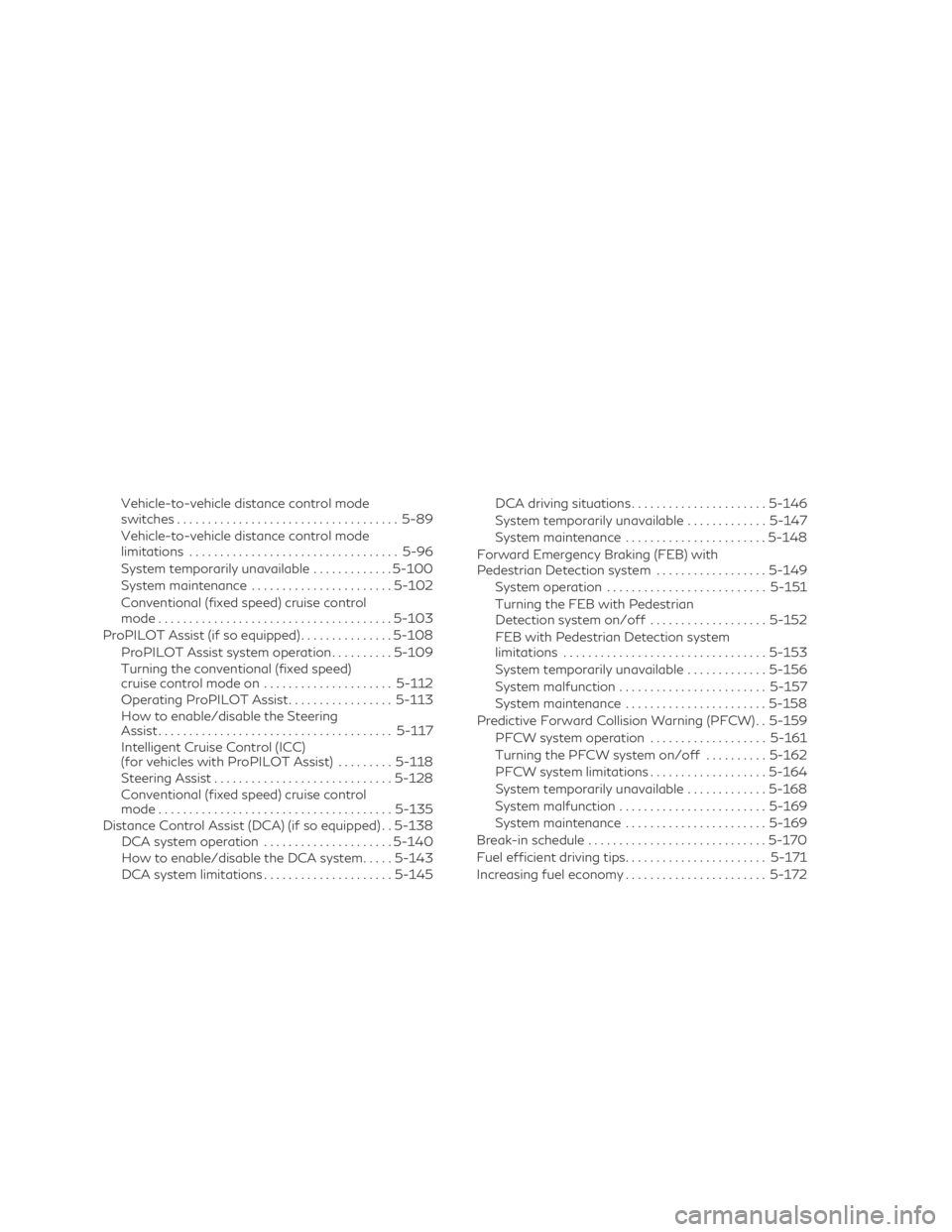
Vehicle-to-vehicle distance control mode
switches.................................... 5-89
Vehicle-to-vehicle distance control mode
limitations .................................. 5-96
System temporarily unavailable .............5-100
System maintenance ....................... 5-102
Conventional (fixed speed) cruise control
mode ...................................... 5-103
ProPILOT Assist (if so equipped) ...............5-108
ProPILOT Assist system operation ..........5-109
Turning the conventional (fixed speed)
cruise control mode on .....................5-112
Operating ProPILOT Assist .................5-113
How to enable/disable the Steering
Assist ...................................... 5-117
Intelligent Cruise Control (ICC)
(for vehicles with ProPILOT Assist) .........5-118
Steering Assist ............................. 5-128
Conventional (fixed speed) cruise control
mode ...................................... 5-135
Distance Control Assist (DCA) (if so equipped) . . 5-138 DCA system operation .....................5-140
How to enable/disable the DCA system .....5-143
DCA system limitations .....................5-145DCA driving situations
...................... 5-146
System temporarily unavailable .............5-147
System maintenance ....................... 5-148
Forward Emergency Braking (FEB) with
Pedestrian Detection system ..................5-149
System operation .......................... 5-151
Turning the FEB with Pedestrian
Detection system on/off ...................5-152
FEB with Pedestrian Detection system
limitations ................................. 5-153
System temporarily unavailable .............5-156
System malfunction ........................ 5-157
System maintenance ....................... 5-158
Predictive Forward Collision Warning (PFCW) . . 5-159 PFCW system operation ...................5-161
Turning the PFCW system on/off ..........5-162
PFCW system limitations ...................5-164
System temporarily unavailable .............5-168
System malfunction ........................ 5-169
System maintenance ....................... 5-169
B
reak-in schedule ............................. 5-170
Fuel efficient driving tips .......................5-171
Increasing fuel economy .......................5-172
Page 262 of 573
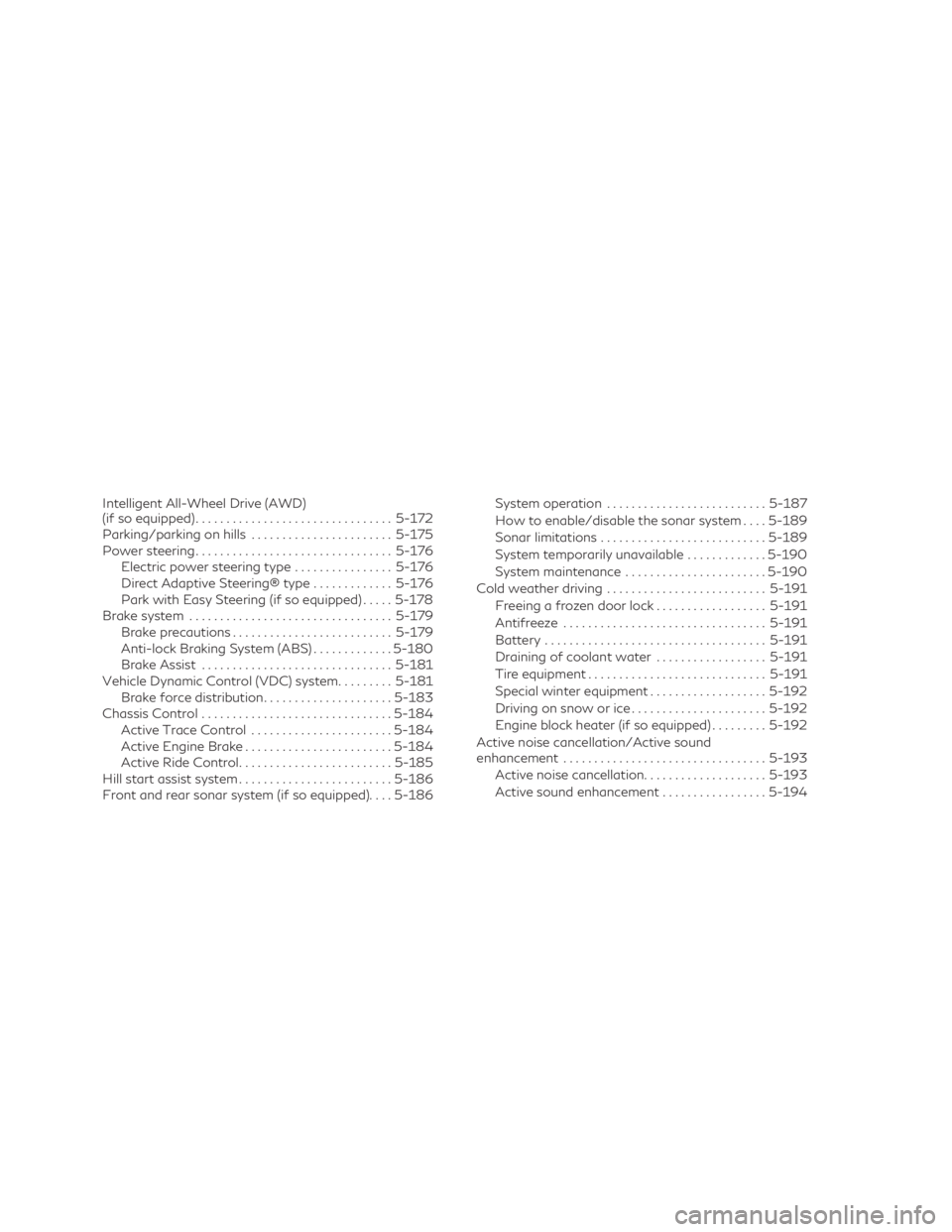
Intelligent All-Wheel Drive (AWD)
(if so equipped)................................ 5-172
Parking/parking on hills .......................5-175
Power steering ................................ 5-176
Electric power steering type ................5-176
Direct Adaptive Steering® type .............5-176
Park with Easy Steering (if so equipped) .....5-178
Brake system ................................. 5-179
Brake precautions .......................... 5-179
Anti-lock Braking System (ABS) .............5-180
Brake Assist ............................... 5-181
Vehicle Dynamic Control (VDC) system .........5-181
Brake force distribution .....................5-183
Chassis Control ............................... 5-184
Active Trace Control ....................... 5-184
Active Engine Brake ........................ 5-184
Active Ride Control ......................... 5-185
Hill start assist system ......................... 5-186
Front and rear sonar system (if so equipped) ....5-186 System operation
.......................... 5-187
How to enable/disable the sonar system ....5-189
Sonar limitations ........................... 5-189
System temporarily unavailable .............5-190
System maintenance ....................... 5-190
Cold weather driving .......................... 5-191
Freeing a frozen door lock ..................5-191
Antifreeze ................................. 5-191
Battery .................................... 5-191
Draining of coolant water ..................5-191
Tire equipment ............................. 5-191
Special winter equipment ...................5-192
Driving on snow or ice ...................... 5-192
Engine block heater (if so equipped) .........5-192
Active noise cancellation/Active sound
enhancement ................................. 5-193
Active noise cancellation ....................5-193
Active soundenhancement ................. 5-194
Page 263 of 573
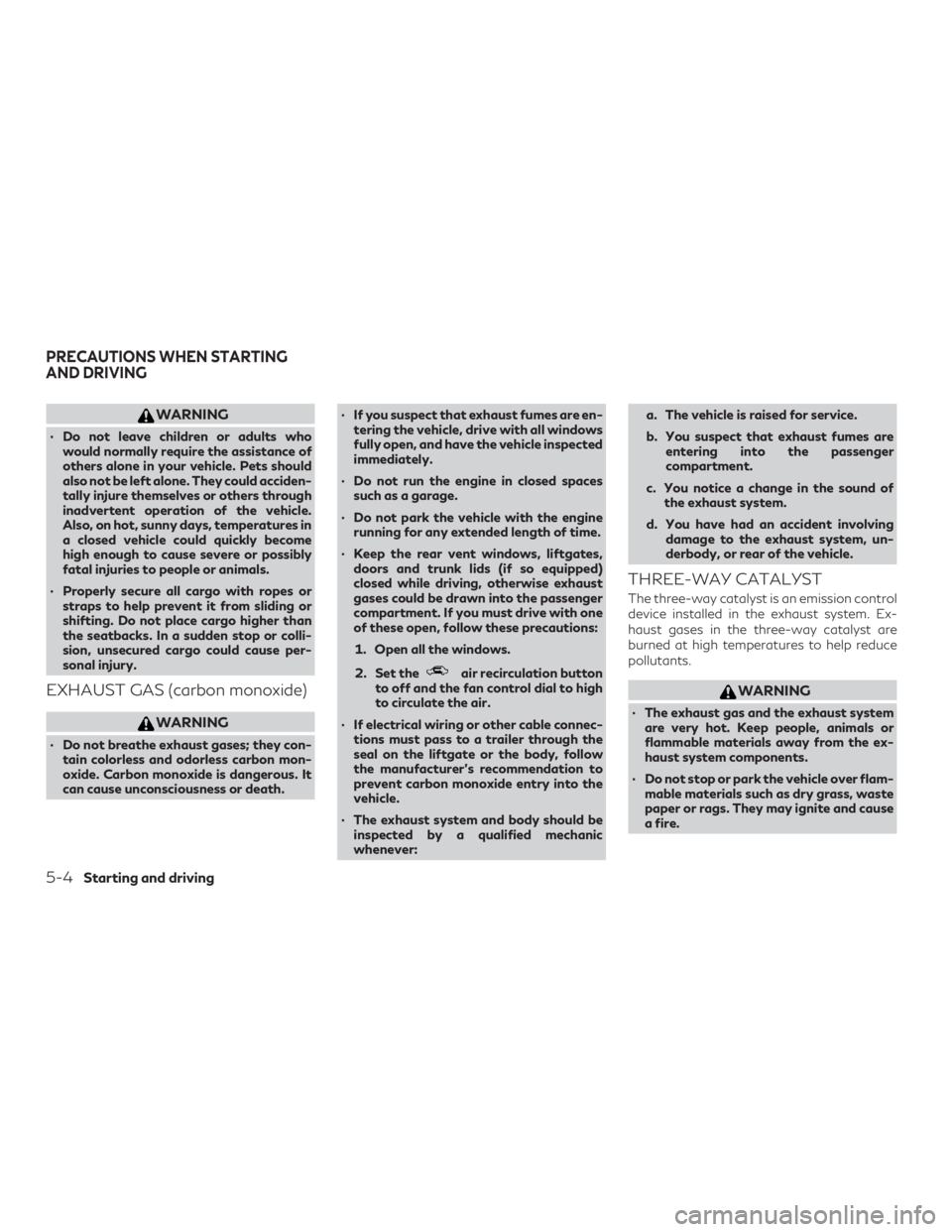
WARNING
∙ Do not leave children or adults whowould normally require the assistance of
others alone in your vehicle. Pets should
also not be left alone. They could acciden-
tally injure themselves or others through
inadvertent operation of the vehicle.
Also, on hot, sunny days, temperatures in
a closed vehicle could quickly become
high enough to cause severe or possibly
fatal injuries to people or animals.
∙ Properly secure all cargo with ropes or straps to help prevent it from sliding or
shifting. Do not place cargo higher than
the seatbacks. In a sudden stop or colli-
sion, unsecured cargo could cause per-
sonal injury.
EXHAUST GAS (carbon monoxide)
WARNING
∙ Do not breathe exhaust gases; they con-tain colorless and odorless carbon mon-
oxide. Carbon monoxide is dangerous. It
can cause unconsciousness or death. ∙ If you suspect that exhaust fumes are en-
tering the vehicle, drive with all windows
fully open, and have the vehicle inspected
immediately.
∙ Do not run the engine in closed spaces such as a garage.
∙ Do not park the vehicle with the engine running for any extended length of time.
∙ Keep the rear vent windows, liftgates, doors and trunk lids (if so equipped)
closed while driving, otherwise exhaust
gases could be drawn into the passenger
compartment. If you must drive with one
of these open, follow these precautions:
1. Open all the windows.
2. Set the
air recirculation button
to off and the fan control dial to high
to circulate the air.
∙ If electrical wiring or other cable connec- tions must pass to a trailer through the
seal on the liftgate or the body, follow
the manufacturer’s recommendation to
prevent carbon monoxide entry into the
vehicle.
∙ The exhaust system and body should be inspected by a qualified mechanic
whenever: a. The vehicle is raised for service.
b. You suspect that exhaust fumes are entering into the passenger
compartment.
c. You notice a change in the sound of the exhaust system.
d. You have had an accident involving damage to the exhaust system, un-
derbody, or rear of the vehicle.
THREE-WAY CATALYST
The three-way catalyst is an emission control
device installed in the exhaust system. Ex-
haust gases in the three-way catalyst are
burned at high temperatures to help reduce
pollutants.
WARNING
∙ The exhaust gas and the exhaust systemare very hot. Keep people, animals or
flammable materials away from the ex-
haust system components.
∙ Do not stop or park the vehicle over flam- mable materials such as dry grass, waste
paper or rags. They may ignite and cause
a fire.
PRECAUTIONS WHEN STARTING
AND DRIVING
5-4Starting and driving
Page 264 of 573
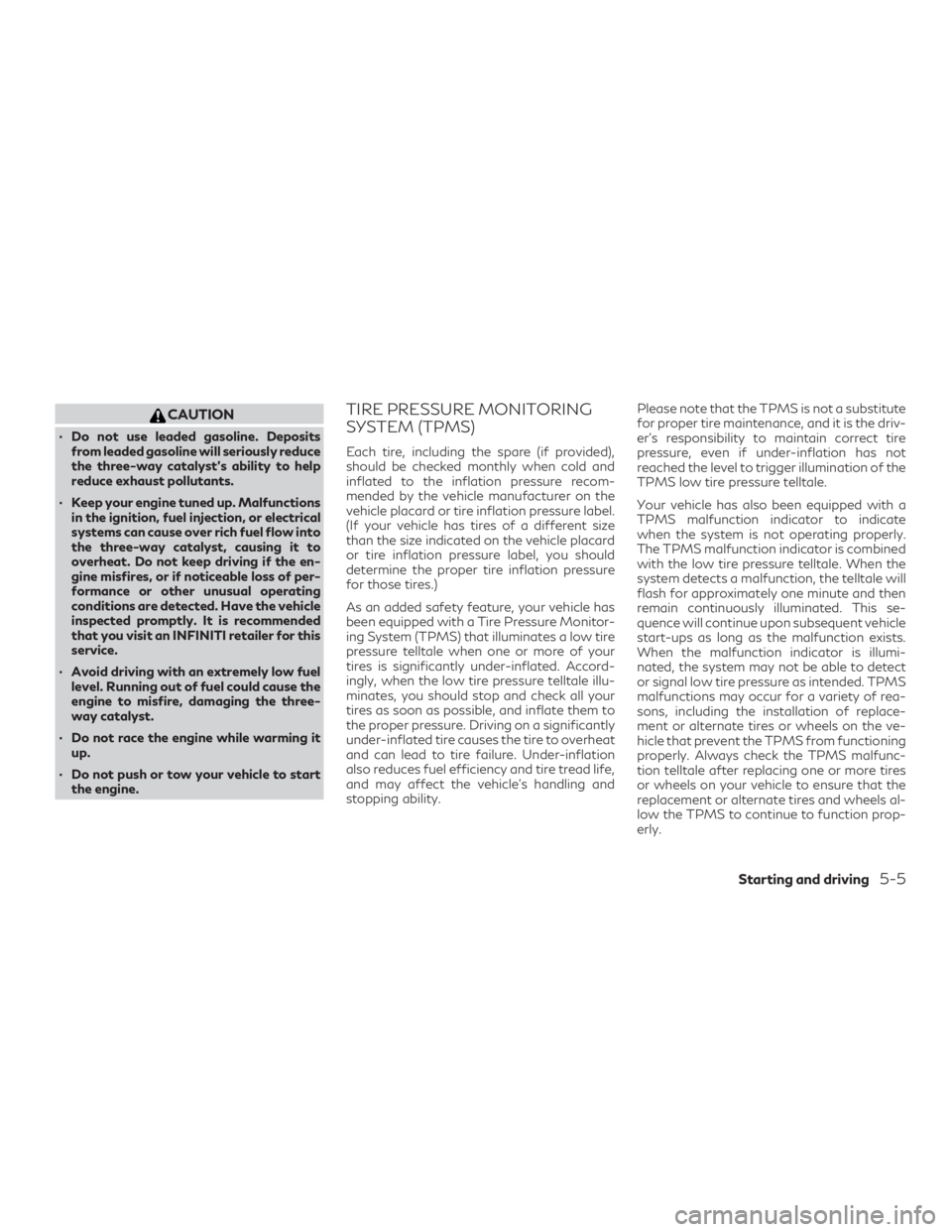
CAUTION
∙ Do not use leaded gasoline. Depositsfrom leaded gasoline will seriously reduce
the three-way catalyst’s ability to help
reduce exhaust pollutants.
∙ Keep your engine tuned up. Malfunctions in the ignition, fuel injection, or electrical
systems can cause over rich fuel flow into
the three-way catalyst, causing it to
overheat. Do not keep driving if the en-
gine misfires, or if noticeable loss of per-
formance or other unusual operating
conditions are detected. Have the vehicle
inspected promptly. It is recommended
that you visit an INFINITI retailer for this
service.
∙ Avoid driving with an extremely low fuel level. Running out of fuel could cause the
engine to misfire, damaging the three-
way catalyst.
∙ Do not race the engine while warming it up.
∙ Do not push or tow your vehicle to start the engine.
TIRE PRESSURE MONITORING
SYSTEM (TPMS)
Each tire, including the spare (if provided),
should be checked monthly when cold and
inflated to the inflation pressure recom-
mended by the vehicle manufacturer on the
vehicle placard or tire inflation pressure label.
(If your vehicle has tires of a different size
than the size indicated on the vehicle placard
or tire inflation pressure label, you should
determine the proper tire inflation pressure
for those tires.)
As an added safety feature, your vehicle has
been equipped with a Tire Pressure Monitor-
ing System (TPMS) that illuminates a low tire
pressure telltale when one or more of your
tires is significantly under-inflated. Accord-
ingly, when the low tire pressure telltale illu-
minates, you should stop and check all your
tires as soon as possible, and inflate them to
the proper pressure. Driving on a significantly
under-inflated tire causes the tire to overheat
and can lead to tire failure. Under-inflation
also reduces fuel efficiency and tire tread life,
and may affect the vehicle’s handling and
stopping ability. Please note that the TPMS is not a substitute
for proper tire maintenance, and it is the driv-
er’s responsibility to maintain correct tire
pressure, even if under-inflation has not
reached the level to trigger illumination of the
TPMS low tire pressure telltale.
Your vehicle has also been equipped with a
TPMS malfunction indicator to indicate
when the system is not operating properly.
The TPMS malfunction indicator is combined
with the low tire pressure telltale. When the
system detects a malfunction, the telltale will
flash for approximately one minute and then
remain continuously illuminated. This se-
quence will continue upon subsequent vehicle
start-ups as long as the malfunction exists.
When the malfunction indicator is illumi-
nated, the system may not be able to detect
or signal low tire pressure as intended. TPMS
malfunctions may occur for a variety of rea-
sons, including the installation of replace-
ment or alternate tires or wheels on the ve-
hicle that prevent the TPMS from functioning
properly. Always check the TPMS malfunc-
tion telltale after replacing one or more tires
or wheels on your vehicle to ensure that the
replacement or alternate tires and wheels al-
low the TPMS to continue to function prop-
erly.
Starting and driving5-5
Page 265 of 573
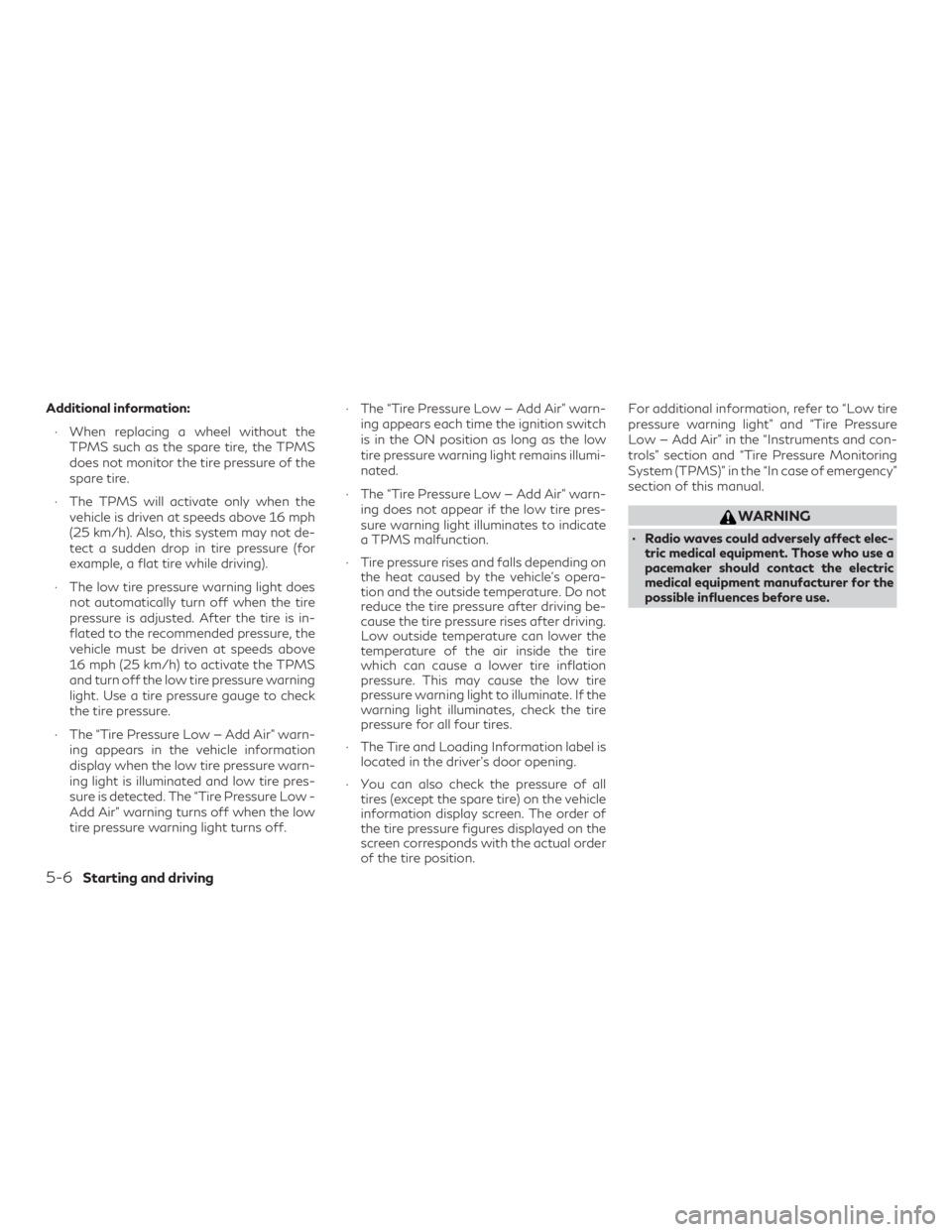
Additional information:∙ When replacing a wheel without the TPMS such as the spare tire, the TPMS
does not monitor the tire pressure of the
spare tire.
∙ The TPMS will activate only when the vehicle is driven at speeds above 16 mph
(25 km/h). Also, this system may not de-
tect a sudden drop in tire pressure (for
example, a flat tire while driving).
∙ The low tire pressure warning light does not automatically turn off when the tire
pressure is adjusted. After the tire is in-
flated to the recommended pressure, the
vehicle must be driven at speeds above
16 mph (25 km/h) to activate the TPMS
and turn off the low tire pressure warning
light. Use a tire pressure gauge to check
the tire pressure.
∙ The “Tire Pressure Low — Add Air” warn- ing appears in the vehicle information
display when the low tire pressure warn-
ing light is illuminated and low tire pres-
sure is detected. The “Tire Pressure Low -
Add Air” warning turns off when the low
tire pressure warning light turns off. ∙ The “Tire Pressure Low — Add Air” warn-
ing appears each time the ignition switch
is in the ON position as long as the low
tire pressure warning light remains illumi-
nated.
∙ The “Tire Pressure Low — Add Air” warn- ing does not appear if the low tire pres-
sure warning light illuminates to indicate
a TPMS malfunction.
∙ Tire pressure rises and falls depending on the heat caused by the vehicle’s opera-
tion and the outside temperature. Do not
reduce the tire pressure after driving be-
cause the tire pressure rises after driving.
Low outside temperature can lower the
temperature of the air inside the tire
which can cause a lower tire inflation
pressure. This may cause the low tire
pressure warning light to illuminate. If the
warning light illuminates, check the tire
pressure for all four tires.
∙ The Tire and Loading Information label is located in the driver’s door opening.
∙ You can also check the pressure of all tires (except the spare tire) on the vehicle
information display screen. The order of
the tire pressure figures displayed on the
screen corresponds with the actual order
of the tire position. For additional information, refer to “Low tire
pressure warning light” and “Tire Pressure
Low — Add Air” in the “Instruments and con-
trols” section and “Tire Pressure Monitoring
System (TPMS)” in the “In case of emergency”
section of this manual.
WARNING
∙ Radio waves could adversely affect elec-
tric medical equipment. Those who use a
pacemaker should contact the electric
medical equipment manufacturer for the
possible influences before use.
5-6Starting and driving
Page 266 of 573
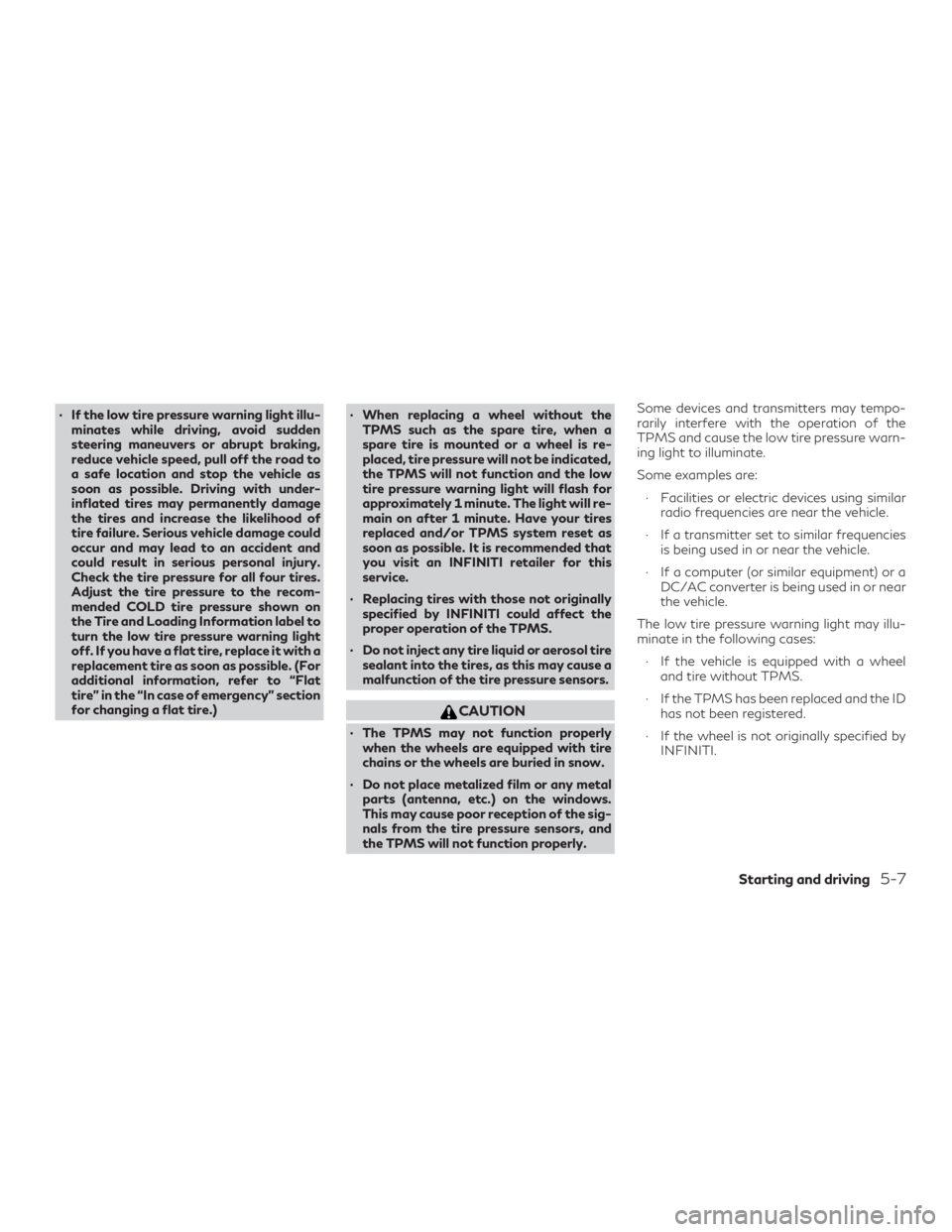
∙ If the low tire pressure warning light illu-minates while driving, avoid sudden
steering maneuvers or abrupt braking,
reduce vehicle speed, pull off the road to
a safe location and stop the vehicle as
soon as possible. Driving with under-
inflated tires may permanently damage
the tires and increase the likelihood of
tire failure. Serious vehicle damage could
occur and may lead to an accident and
could result in serious personal injury.
Check the tire pressure for all four tires.
Adjust the tire pressure to the recom-
mended COLD tire pressure shown on
the Tire and Loading Information label to
turn the low tire pressure warning light
off. If you have a flat tire, replace it with a
replacement tire as soon as possible. (For
additional information, refer to “Flat
tire” in the “In case of emergency” section
for changing a flat tire.) ∙ When replacing a wheel without the
TPMS such as the spare tire, when a
spare tire is mounted or a wheel is re-
placed, tire pressure will not be indicated,
the TPMS will not function and the low
tire pressure warning light will flash for
approximately 1 minute. The light will re-
main on after 1 minute. Have your tires
replaced and/or TPMS system reset as
soon as possible. It is recommended that
you visit an INFINITI retailer for this
service.
∙ Replacing tires with those not originally specified by INFINITI could affect the
proper operation of the TPMS.
∙ Do not inject any tire liquid or aerosol tire sealant into the tires, as this may cause a
malfunction of the tire pressure sensors.
CAUTION
∙ The TPMS may not function properlywhen the wheels are equipped with tire
chains or the wheels are buried in snow.
∙ Do not place metalized film or any metal parts (antenna, etc.) on the windows.
This may cause poor reception of the sig-
nals from the tire pressure sensors, and
the TPMS will not function properly. Some devices and transmitters may tempo-
rarily interfere with the operation of the
TPMS and cause the low tire pressure warn-
ing light to illuminate.
Some examples are:
∙ Facilities or electric devices using similar radio frequencies are near the vehicle.
∙ If a transmitter set to similar frequencies is being used in or near the vehicle.
∙ If a computer (or similar equipment) or a DC/AC converter is being used in or near
the vehicle.
The low tire pressure warning light may illu-
minate in the following cases: ∙ If the vehicle is equipped with a wheel and tire without TPMS.
∙ If the TPMS has been replaced and the ID has not been registered.
∙ If the wheel is not originally specified by INFINITI.
Starting and driving5-7
Page 267 of 573
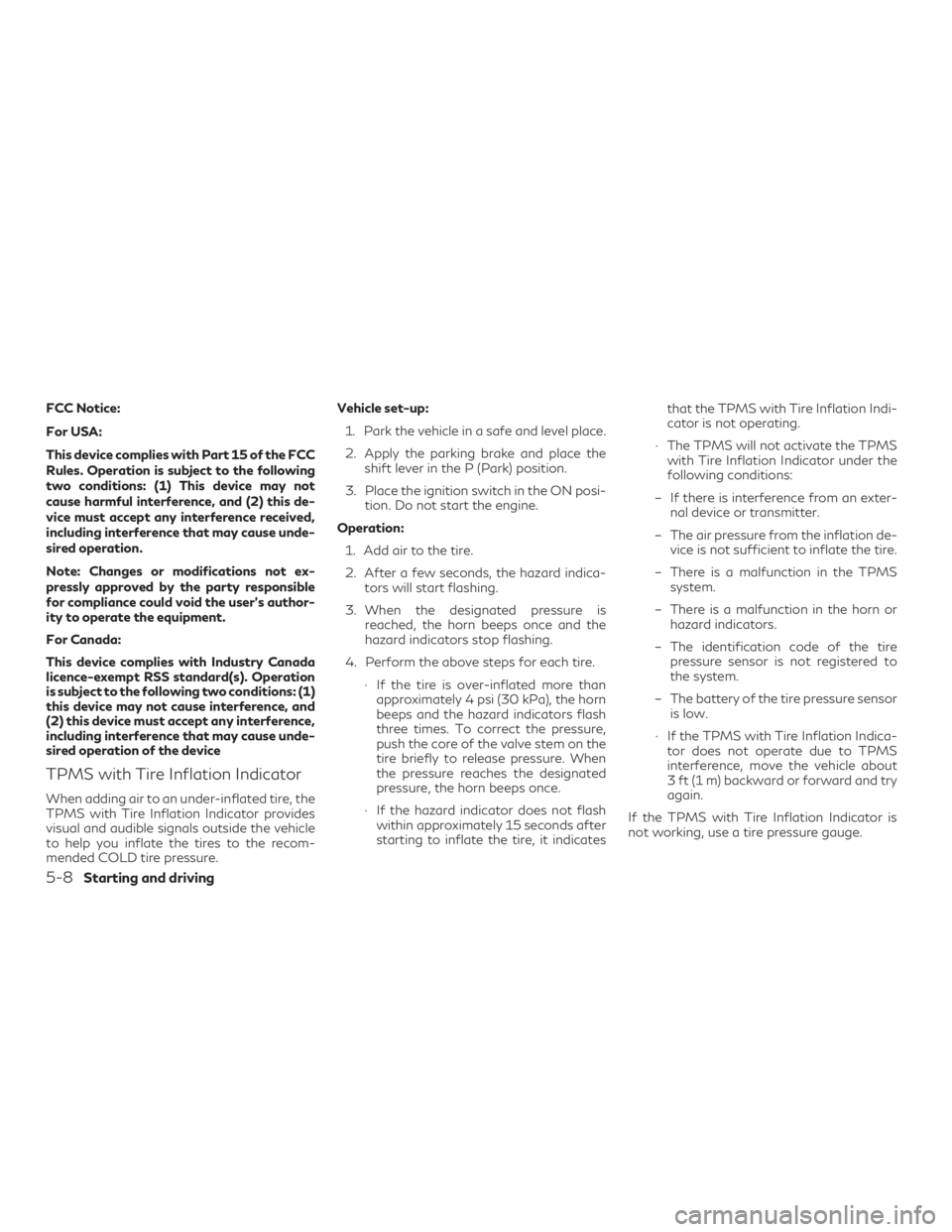
FCC Notice:
For USA:
This device complies with Part 15 of the FCC
Rules. Operation is subject to the following
two conditions: (1) This device may not
cause harmful interference, and (2) this de-
vice must accept any interference received,
including interference that may cause unde-
sired operation.
Note: Changes or modifications not ex-
pressly approved by the party responsible
for compliance could void the user’s author-
ity to operate the equipment.
For Canada:
This device complies with Industry Canada
licence-exempt RSS standard(s). Operation
is subject to the following two conditions: (1)
this device may not cause interference, and
(2) this device must accept any interference,
including interference that may cause unde-
sired operation of the device
TPMS with Tire Inflation Indicator
When adding air to an under-inflated tire, the
TPMS with Tire Inflation Indicator provides
visual and audible signals outside the vehicle
to help you inflate the tires to the recom-
mended COLD tire pressure.Vehicle set-up:
1. Park the vehicle in a safe and level place.
2. Apply the parking brake and place the shift lever in the P (Park) position.
3. Place the ignition switch in the ON posi- tion. Do not start the engine.
Operation: 1. Add air to the tire.
2. After a few seconds, the hazard indica- tors will start flashing.
3. When the designated pressure is reached, the horn beeps once and the
hazard indicators stop flashing.
4. Perform the above steps for each tire. ∙ If the tire is over-inflated more thanapproximately 4 psi (30 kPa), the horn
beeps and the hazard indicators flash
three times. To correct the pressure,
push the core of the valve stem on the
tire briefly to release pressure. When
the pressure reaches the designated
pressure, the horn beeps once.
∙ If the hazard indicator does not flash within approximately 15 seconds after
starting to inflate the tire, it indicates that the TPMS with Tire Inflation Indi-
cator is not operating.
∙ The TPMS will not activate the TPMS with Tire Inflation Indicator under the
following conditions:
– If there is interference from an exter- nal device or transmitter.
– The air pressure from the inflation de- vice is not sufficient to inflate the tire.
– There is a malfunction in the TPMS system.
– There is a malfunction in the horn or hazard indicators.
– The identification code of the tire pressure sensor is not registered to
the system.
– The battery of the tire pressure sensor is low.
∙ If the TPMS with Tire Inflation Indica- tor does not operate due to TPMS
interference, move the vehicle about
3 ft (1 m) backward or forward and try
again.
If the TPMS with Tire Inflation Indicator is
not working, use a tire pressure gauge.
5-8Starting and driving
Page 268 of 573
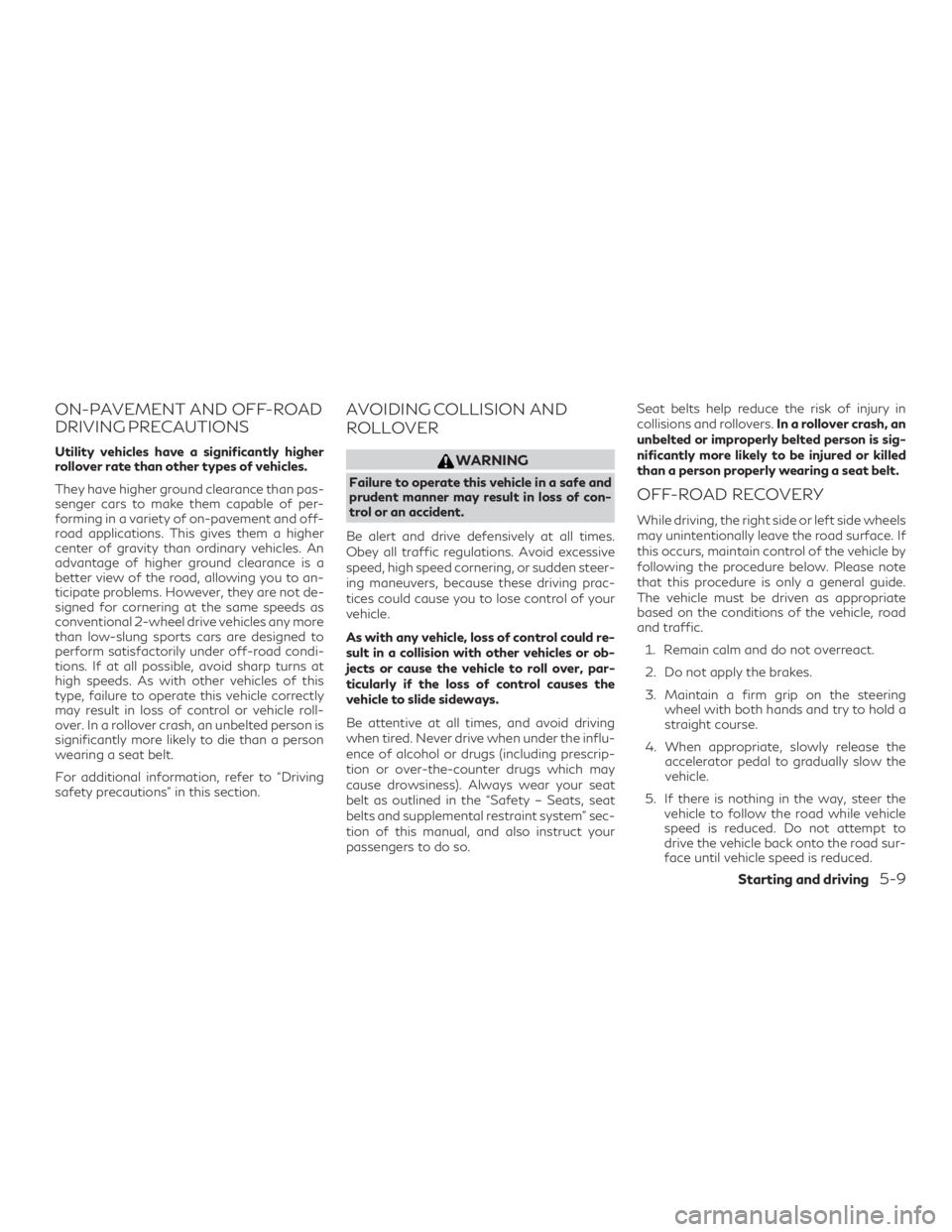
ON-PAVEMENT AND OFF-ROAD
DRIVING PRECAUTIONS
Utility vehicles have a significantly higher
rollover rate than other types of vehicles.
They have higher ground clearance than pas-
senger cars to make them capable of per-
forming in a variety of on-pavement and off-
road applications. This gives them a higher
center of gravity than ordinary vehicles. An
advantage of higher ground clearance is a
better view of the road, allowing you to an-
ticipate problems. However, they are not de-
signed for cornering at the same speeds as
conventional 2-wheel drive vehicles any more
than low-slung sports cars are designed to
perform satisfactorily under off-road condi-
tions. If at all possible, avoid sharp turns at
high speeds. As with other vehicles of this
type, failure to operate this vehicle correctly
may result in loss of control or vehicle roll-
over. In a rollover crash, an unbelted person is
significantly more likely to die than a person
wearing a seat belt.
For additional information, refer to “Driving
safety precautions” in this section.
AVOIDING COLLISION AND
ROLLOVER
WARNING
Failure to operate this vehicle in a safe and
prudent manner may result in loss of con-
trol or an accident.
Be alert and drive defensively at all times.
Obey all traffic regulations. Avoid excessive
speed, high speed cornering, or sudden steer-
ing maneuvers, because these driving prac-
tices could cause you to lose control of your
vehicle.
As with any vehicle, loss of control could re-
sult in a collision with other vehicles or ob-
jects or cause the vehicle to roll over, par-
ticularly if the loss of control causes the
vehicle to slide sideways.
Be attentive at all times, and avoid driving
when tired. Never drive when under the influ-
ence of alcohol or drugs (including prescrip-
tion or over-the-counter drugs which may
cause drowsiness). Always wear your seat
belt as outlined in the “Safety – Seats, seat
belts and supplemental restraint system” sec-
tion of this manual, and also instruct your
passengers to do so. Seat belts help reduce the risk of injury in
collisions and rollovers.
In a rollover crash, an
unbelted or improperly belted person is sig-
nificantly more likely to be injured or killed
than a person properly wearing a seat belt.OFF-ROAD RECOVERY
While driving, the right side or left side wheels
may unintentionally leave the road surface. If
this occurs, maintain control of the vehicle by
following the procedure below. Please note
that this procedure is only a general guide.
The vehicle must be driven as appropriate
based on the conditions of the vehicle, road
and traffic.
1. Remain calm and do not overreact.
2. Do not apply the brakes.
3. Maintain a firm grip on the steering wheel with both hands and try to hold a
straight course.
4. When appropriate, slowly release the accelerator pedal to gradually slow the
vehicle.
5. If there is nothing in the way, steer the vehicle to follow the road while vehicle
speed is reduced. Do not attempt to
drive the vehicle back onto the road sur-
face until vehicle speed is reduced.
Starting and driving5-9
Page 269 of 573
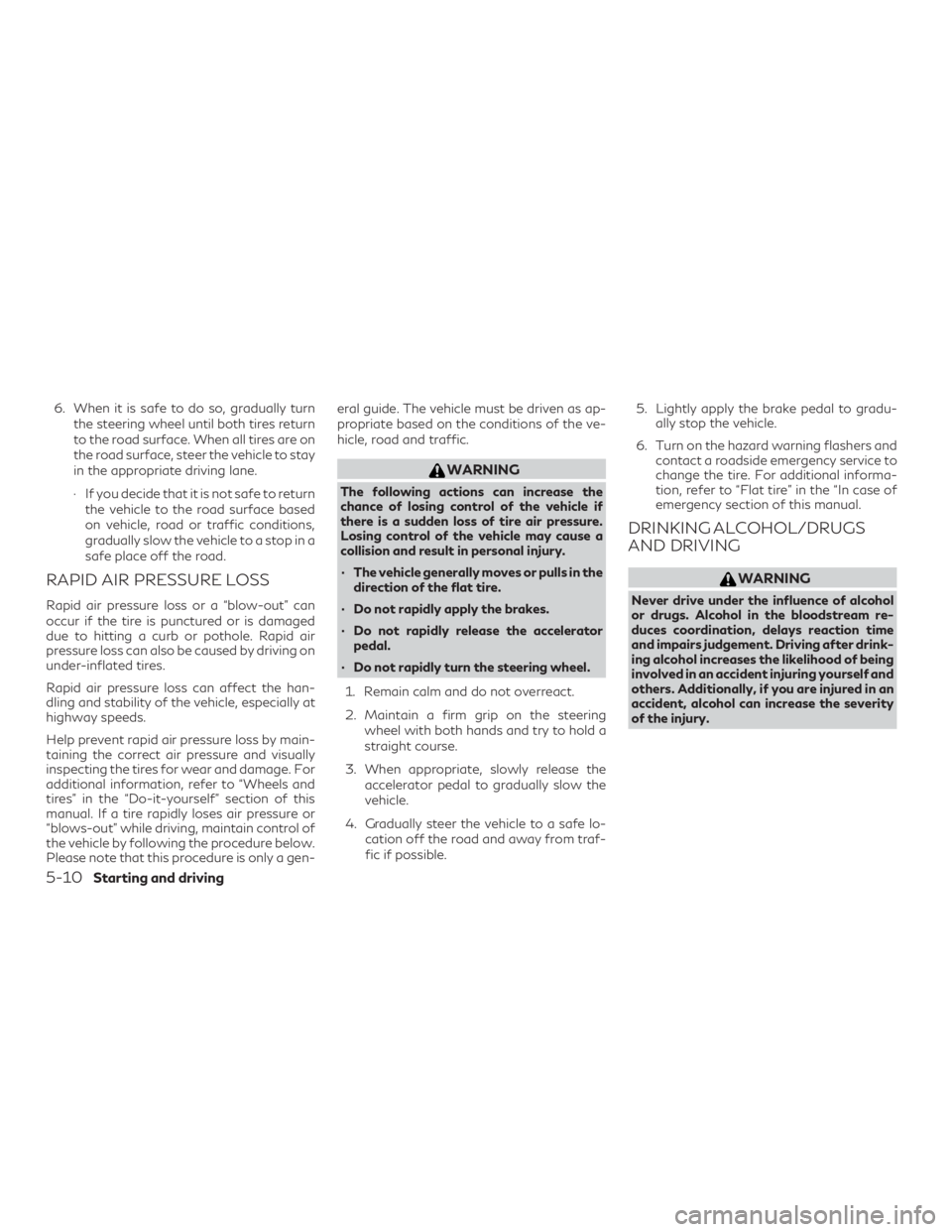
6. When it is safe to do so, gradually turnthe steering wheel until both tires return
to the road surface. When all tires are on
the road surface, steer the vehicle to stay
in the appropriate driving lane.
∙ If you decide that it is not safe to return the vehicle to the road surface based
on vehicle, road or traffic conditions,
gradually slow the vehicle to a stop in a
safe place off the road.
RAPID AIR PRESSURE LOSS
Rapid air pressure loss or a “blow-out” can
occur if the tire is punctured or is damaged
due to hitting a curb or pothole. Rapid air
pressure loss can also be caused by driving on
under-inflated tires.
Rapid air pressure loss can affect the han-
dling and stability of the vehicle, especially at
highway speeds.
Help prevent rapid air pressure loss by main-
taining the correct air pressure and visually
inspecting the tires for wear and damage. For
additional information, refer to “Wheels and
tires” in the “Do-it-yourself” section of this
manual. If a tire rapidly loses air pressure or
“blows-out” while driving, maintain control of
the vehicle by following the procedure below.
Please note that this procedure is only a gen- eral guide. The vehicle must be driven as ap-
propriate based on the conditions of the ve-
hicle, road and traffic.
WARNING
The following actions can increase the
chance of losing control of the vehicle if
there is a sudden loss of tire air pressure.
Losing control of the vehicle may cause a
collision and result in personal injury.
∙ The vehicle generally moves or pulls in the
direction of the flat tire.
∙ Do not rapidly apply the brakes.
∙ Do not rapidly release the accelerator pedal.
∙ Do not rapidly turn the steering wheel.
1. Remain calm and do not overreact.
2. Maintain a firm grip on the steering wheel with both hands and try to hold a
straight course.
3. When appropriate, slowly release the accelerator pedal to gradually slow the
vehicle.
4. Gradually steer the vehicle to a safe lo- cation off the road and away from traf-
fic if possible. 5. Lightly apply the brake pedal to gradu-
ally stop the vehicle.
6. Turn on the hazard warning flashers and contact a roadside emergency service to
change the tire. For additional informa-
tion, refer to “Flat tire” in the “In case of
emergency section of this manual.
DRINKING ALCOHOL/DRUGS
AND DRIVING
WARNING
Never drive under the influence of alcohol
or drugs. Alcohol in the bloodstream re-
duces coordination, delays reaction time
and impairs judgement. Driving after drink-
ing alcohol increases the likelihood of being
involved in an accident injuring yourself and
others. Additionally, if you are injured in an
accident, alcohol can increase the severity
of the injury.
5-10Starting and driving
Page 270 of 573
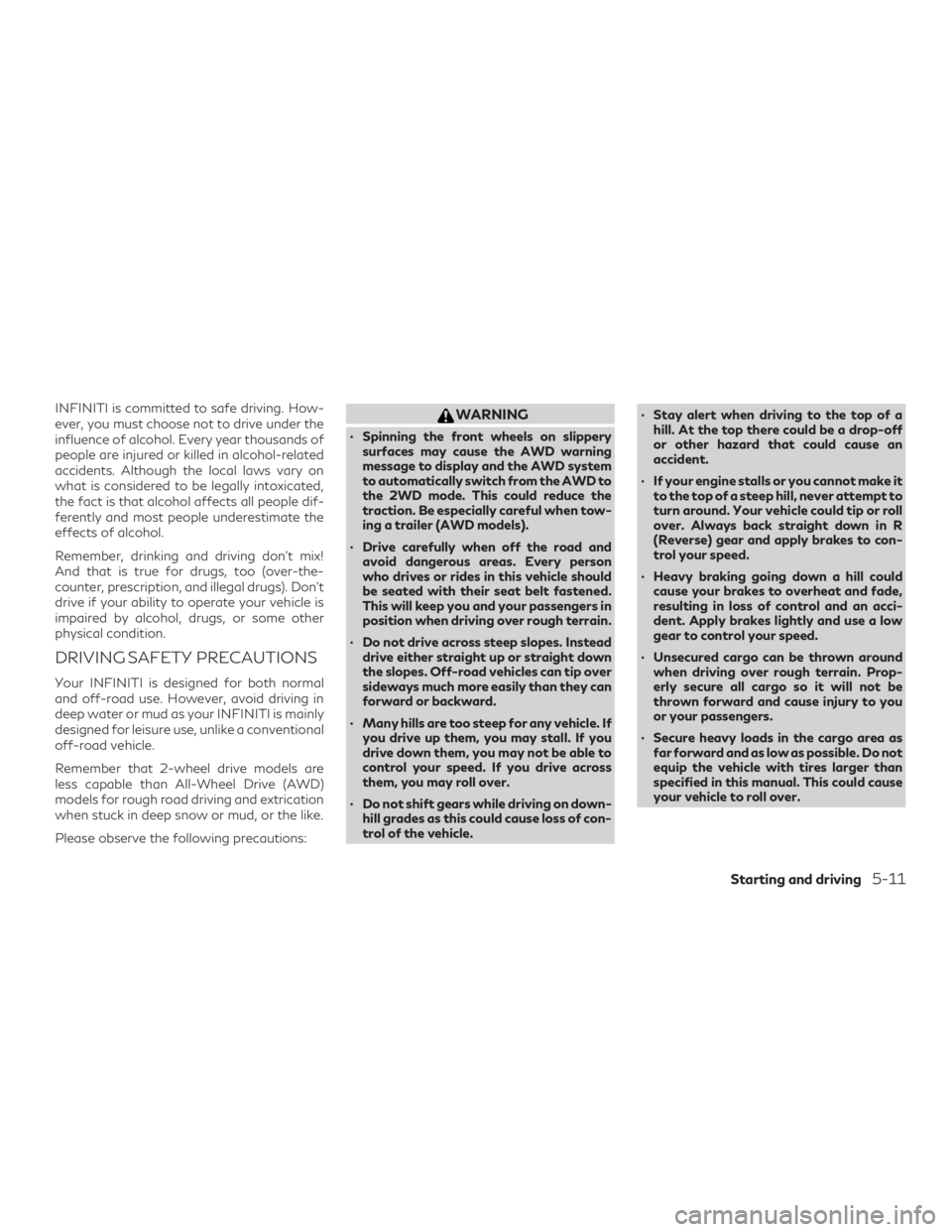
INFINITI is committed to safe driving. How-
ever, you must choose not to drive under the
influence of alcohol. Every year thousands of
people are injured or killed in alcohol-related
accidents. Although the local laws vary on
what is considered to be legally intoxicated,
the fact is that alcohol affects all people dif-
ferently and most people underestimate the
effects of alcohol.
Remember, drinking and driving don’t mix!
And that is true for drugs, too (over-the-
counter, prescription, and illegal drugs). Don’t
drive if your ability to operate your vehicle is
impaired by alcohol, drugs, or some other
physical condition.
DRIVING SAFETY PRECAUTIONS
Your INFINITI is designed for both normal
and off-road use. However, avoid driving in
deep water or mud as your INFINITI is mainly
designed for leisure use, unlike a conventional
off-road vehicle.
Remember that 2-wheel drive models are
less capable than All-Wheel Drive (AWD)
models for rough road driving and extrication
when stuck in deep snow or mud, or the like.
Please observe the following precautions:
WARNING
∙ Spinning the front wheels on slipperysurfaces may cause the AWD warning
message to display and the AWD system
to automatically switch from the AWD to
the 2WD mode. This could reduce the
traction. Be especially careful when tow-
ing a trailer (AWD models).
∙ Drive carefully when off the road and avoid dangerous areas. Every person
who drives or rides in this vehicle should
be seated with their seat belt fastened.
This will keep you and your passengers in
position when driving over rough terrain.
∙ Do not drive across steep slopes. Instead drive either straight up or straight down
the slopes. Off-road vehicles can tip over
sideways much more easily than they can
forward or backward.
∙ Many hills are too steep for any vehicle. If you drive up them, you may stall. If you
drive down them, you may not be able to
control your speed. If you drive across
them, you may roll over.
∙ Do not shift gears while driving on down- hill grades as this could cause loss of con-
trol of the vehicle. ∙ Stay alert when driving to the top of a
hill. At the top there could be a drop-off
or other hazard that could cause an
accident.
∙ If your engine stalls or you cannot make it to the top of a steep hill, never attempt to
turn around. Your vehicle could tip or roll
over. Always back straight down in R
(Reverse) gear and apply brakes to con-
trol your speed.
∙ Heavy braking going down a hill could cause your brakes to overheat and fade,
resulting in loss of control and an acci-
dent. Apply brakes lightly and use a low
gear to control your speed.
∙ Unsecured cargo can be thrown around when driving over rough terrain. Prop-
erly secure all cargo so it will not be
thrown forward and cause injury to you
or your passengers.
∙ Secure heavy loads in the cargo area as far forward and as low as possible. Do not
equip the vehicle with tires larger than
specified in this manual. This could cause
your vehicle to roll over.
Starting and driving5-11